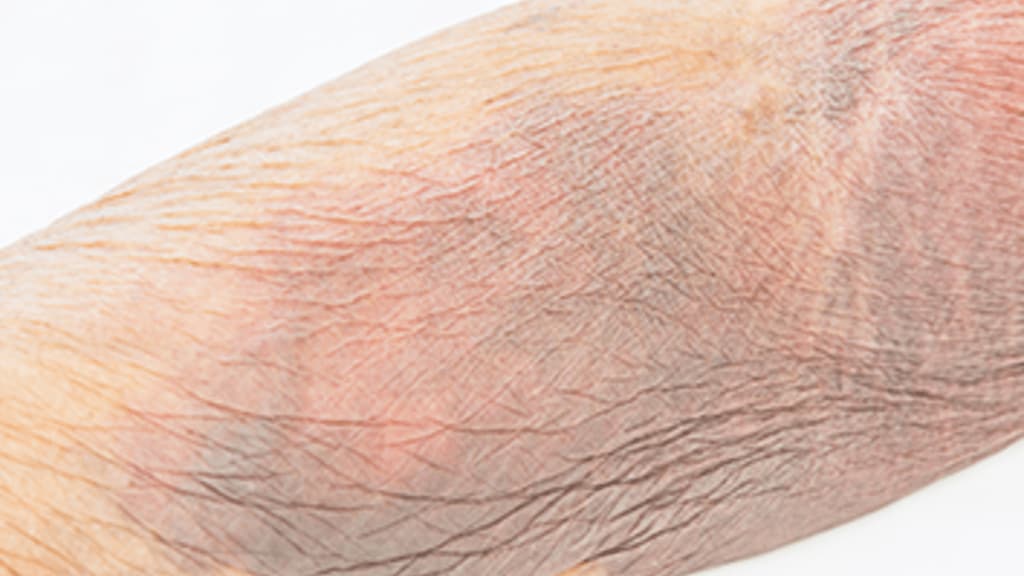Bruising and Bleeding

Everybody gets bruises or bleeds at some point. Bruises result from blood pooling under the skin after an injury and are common on areas such as the arms and legs. People often bruise more easily as they get older. Bleeding happens when blood vessels are broken because of a cut, medical event, or injury, but can also be a normal part of life, for example, menstruation (periods) in women. Knowing when a bruise or an instance of bleeding is normal and to be expected versus one that requires further investigation is important.
Normal Vs Abnormal Bruising or Bleeding
Bruising or bleeding after an injury is normal but there are some medical conditions or genetic disorders that cause people to bruise or bleed too easily or bruise or bleed spontaneously, without any triggering event or injury. The most common places for spontaneous bleeding are the nose, mouth, and the digestive tract.
Hemophilia is a condition in which the ability of the blood to clot is severely reduced, causing a person to bleed severely from even a slight injury, usually into their joints or muscles. It is usually caused by a hereditary lack of a coagulation factor, most often factor VIII. Most often, bleeding is minor, but it can be severe enough to be life-threatening.
Symptoms of Unusual Bleeding or Bruising
- Bruising in unusual places, such as the back, or hands
- Bruises that take a long time to fade
- Bruising without damage to that part of the body
- Excessive bleeding after tooth brushing or flossing
- Excessive or prolonged menstrual blood flow (menorrhagia)
- Multiple bruises
- Prolonged bleeding after minor cuts, or after blood has been taken
- Prolonged bleeding after surgery or dental procedures
- Tiny red or purple dots on the skin (petechiae)
- Other unusual skin markings, such as red or purple patches (purpura), many bruises (ecchymoses), or visible blood vessels (telangiectasias).
Causes of easy bruising or bleeding
Problems with bruising and bleeding are often inherited and show up early in life. Other common causes of excessive bruising or bleeding include:
- Clotting disorders such as hemophilia A or B or Von Willebrand disease
- Cushing’s syndrome
- Ehlers-Danlos syndrome (EDS)
- Leukemia
- Liver disease
- Low platelet counts
- Medications, such as aspirin, NSAIDs, blood thinners, or some herbal medicines
- Poor nutrition or vitamin deficiencies.
When to Talk to Your Doctor
Talk to your doctor if you have:
- Bleeding that doesn't stop after 10 minutes
- Bruising that occurs in unusual places or takes a long time to resolve
- Excessive bleeding from minor cuts or cuts take a long time to stop bleeding
- Family members who also have problems with bruising or bleeding
- Large or frequent bruises that you can't remember getting
- More than five nosebleeds in a year
- Periods that last more than seven days or periods that are so heavy that you have to change your pad more than every two hours.
Your doctor may take a blood test to see if there is any reason for your easy bruising or bleeding.
Treatment of Bruises or Bleeding
Treatment depends on whether the bruising or bleeding is excessive, severe, or persistent and the underlying cause. Treatment options may include:
- Blood or platelet transfusions
- Fresh frozen plasma
- Giving vitamins or other supplements to correct a deficiency
- Stopping medications that might be contributing to the bruising and bleeding
- Treating any cancers or infections
- People with liver disease are sometimes given vitamin K or fresh frozen plasma transfusions.
Article references
- Easy Bruising and Bleeding. Am Fam Physician. 2016 Feb 15;93(4) https://www.aafp.org/afp/2016/0215/p279-s1.html
- Bruising in leukaemia VS ordinary bruising. 2022. Leukemia Care. https://www.leukaemiacare.org.uk/support-and-information/latest-from-leukaemia-care/blog/spotting-the-difference-bruising-in-leukaemia-vs-ordinary-bruising/



